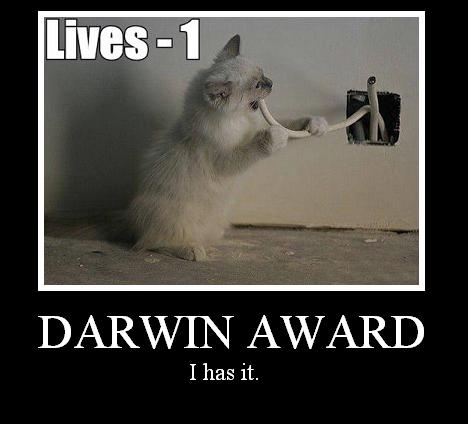p>Welcome to the One Hundred and Ninth Edition of The Tangled Bank, the Weblog Carnival of Evolutionary Biology. This is the LOL edition of the Tangled Bank....

Carnival business ...
The main page for The Tangled Bank is here. The previous edition of The Tangled Bank was here, at Wheatdogg, and the next edition of the Tangled Bank will be here, at Blue Collar Scientist.
And now, on with the show. ...
In Small Things Considered...
Rational redesign of bacterial signaling proteins based on amino acid co-evolution at Chance and Necessity is a bit of Peer Reviewed Research Blogging, covering an article by Skerker et al on "rewiring the specificity of two-component signal transduction systems." It all begins and ends with cells:
...cells must have the ability to respond to their environment in an appropriate fashion. Responding to physical and chemical aspects of the environment is crucial, but so is responding to neighboring cells that also inhabit that environment. In multicellular animals a surprisingly small set of molecules coordinate the complex communication between cells...
To your health! ....
Eating can be bad for your health. Oh, and don't forget the phages. by PalMD at denialism blog looks at bacteria, viruses, phages, transduction, and and diseases of the gut. Its pretty complicated.
Most lay-people haven't heard of phages, and most physicians probably don't think about them very often, but phages represent an enormously important part of biology and medicine. They cause disease, they can be a vehicle for certain therapies, and ultimately, they represent a large part of the biosphere's genetic information.
A piece by Pamela Ronald printed in The Boston Globe: The new organic: The future of food may depend on an unlikely marriage: organic farmers and genetic engineering.
The world faces an enormous challenge: Its growing population demands more food and other crops, but standard commercial agriculture uses industrial quantities of pesticides and harms the environment in other ways. The organic farming movement has shown that it is possible to dramatically reduce the use of insecticides, and that doing so benefits both farm workers and the environment. But organic farming also has serious limits - there are many pests and diseases that cannot be controlled using organic approaches, and organic crops are generally more expensive to produce and buy.
[A brief digression: Speaking of engineering of crops, check out this post by BodBlack Blog on Rice Paddy Art, which is a form of Crop Circle-ery: Crop Circles? Try Rice Paddy Art! You will not believe what can be done with a rice paddy!!!!!]
A DC Birding Blog explores the relationship between Bird Diversity and the West Nile Virus. The more diversity (among birds) the less likely bird to human transition would be, according to the PLoS ONE peer reviewed article covered in this post.
The health of the spotted owl (Strix occidentalis) is threatened by disease carried by the Barred owls ( Strix varia), which, in turn is spreading its range quite dramatically. This is a problem as well in other avian species. Malaria and vector-borne diseases or blood parasites are the culprit. Spotted Owls and Barred Owls: Whoooo Has Malaria? at Guadalupe Storm-Petrel Blog has the blood chilling story, based on the examination of a couple of peer-reviewed research papers.
A little sexual orientation with your hormones?....
The Evolving Mind asks, can you Just Say "No" to Hormones? This is a veritable mini carnival of its own, investigating sexual development, onset of sexual activities, and sexual orientation and behavior in humans.....
One hot summer day I ventured over to my neighbor's house for a pool party. The daughter, a recent graduate of puberty, was sporting a bikini. I absolutely couldn't keep my eyes off her. I was fascinated, bewitched....
Systems.....
Agricultural Biodiversity Weblog presents two pieces, both on, well, biodiversity stuff. The first is a review of a peer reviewed article on rice grain size genetics called Growing bigger rice grains. The second addresses the very important issue of The perils of protected areas under conditions of climate change. This, by the way, is one of the key important answers to the rather dumb question: So what if it gets warmer???
An organism ...
Go down to Jamaica Bay and you will hear a lot of noisy insects in the trees. Except a lot of them are frogs. And some of them are gray tree frogs (Hyla versicolor). Tree frogs are one of those things that I find many people refuse to believe exists. 10,000 Birds (the web log, not the large flock) presents a close up photographic essay of this amazing beastie.
In the beginning ....
Mike Haubrich, writing at Clashing Culture, takes on the question of Evolution and the Origin of Life.
I have often been frustrated by creationists claiming that evolution can't explain the origins of life, but even more irritated when evolution's defenders try to halt the discussion by saying that "Evolution doesn't address abiogenesis, evolution starts when the first life appears."
Indeed, that is very frustrating.
If the Clashing Culture war over evolution is to be won based on the examination of the data, conceding incorrect points gives creationists ammunition. People who care about evolution really need to address all of the faulty points and not concede points as important as the 19th century view of the cell.
Read this important post.
"Clowns to the left of me, jokers to the right..."
Both Conservative & Liberal Extremists Have Issues with Science, says Colloquy.
... the political dangers of the "religious right" are front and center in my thoughts most of the time. I have lost a couple of friends here because I've found that I am intolerant of people that are intolerant ... I was, however, reminded recently that scientific ignorance is abundant on the "extreme left" as well. I wanted to slap myself in the head as it was brought to my attention recently.
Have you ever heard of Iridology?
Iridologists believe--or at least they say they believe it--that they can diagnose all sorts of physical and mental illnesses by studying the appearance and location of features on the iris of the eye. The claim that the iris can be directly mapped to various organs and regions of the human body, and that certain features can signify specific illnesses in the mapped regions. For example, they claim the part of the iris near the six o'clock position correlates to the kidney. Features located in this area denote illness or disease of the kidney.
Well, I suppose that is one way to earn a living ... Find out how YOU TOO can be an iridologist, here, at Skepticemia....
This has always been an interest of mine... the evolution of the eye. I had always assumed that the molluskan and vertebrate lineages of eye evolution represented homplasies that happen to use a couple of the same genetic substrates because of constraint on those genes. Well, I was right, according to Box Jellies and the Red Herring of Eye Evolution
Kozmik and colleagues favor the conclusion of parallel evolution - the separate assembly of homologous ("the same") components to form eyes. In other words, they argue that box jellies and vertebrates separately evolved eyes, but happened to use the same components in each case, opsin and melanin.
That is all.



